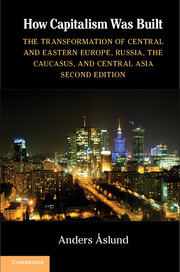 How Capitalism Was Built
How Capitalism Was Built Book contents
- Frontmatter
- Contents
- List of Tables and Figures
- Acknowledgments
- List of Abbreviations
- Introduction
- 1 Communism and Its Demise
- 2 Radical Reform versus Gradualism
- 3 Output
- 4 Liberalization
- 5 From Hyperinflation to Financial Stability
- 6 Privatization
- 7 The Social System
- 8 The Politics of Transition
- 9 From Crime Toward Law
- 10 The Importance of the European Union
- 11 The Global Financial Crisis, 2007–2012
- 12 Conclusions
- Bibliography
- Index
12 - Conclusions
A World Transformed
Published online by Cambridge University Press: 05 December 2012
- Frontmatter
- Contents
- List of Tables and Figures
- Acknowledgments
- List of Abbreviations
- Introduction
- 1 Communism and Its Demise
- 2 Radical Reform versus Gradualism
- 3 Output
- 4 Liberalization
- 5 From Hyperinflation to Financial Stability
- 6 Privatization
- 7 The Social System
- 8 The Politics of Transition
- 9 From Crime Toward Law
- 10 The Importance of the European Union
- 11 The Global Financial Crisis, 2007–2012
- 12 Conclusions
- Bibliography
- Index
Summary
The changes that have taken place in Central and Eastern Europe and the former Soviet Union are nothing but extraordinary. At the same time, it is striking how uneven progress has been. Some countries appear to have done it all, but others have barely taken the first steps. Market economic reforms have been highly successful, whereas democratization has been only partially auspicious, and the introduction of the rule of law even less so.
To assess how far the region has proceeded, these countries are first summarized as three models reflecting a broadening chasm between the European Union (EU) countries and the post-Soviet countries. Finally, I recapitulate major developments in the region.
A BROADENING DIVIDE BETWEEN THE EU AND THE POST-SOVIET WORLD
The outcomes of the postcommunist transformation have been remarkably different. Today these twenty-one countries that were once so similar have become rather diverse. Eighteen have become market economies, but three (Belarus, Turkmenistan, and Uzbekistan) have not (see Table 12.1). The same eighteen countries have privatized an average of two-thirds or more of their economies, but the other three derive only a third of their gross domestic product (GDP) from the private sector. Inflation is under control in the single digits everywhere but in Belarus. The growth rates generally were low or negative in the 1990s, but the whole region enjoyed splendid economic growth in the boom years 2000–7, especially the post-Soviet and Baltic countries (see Table 12.1).
- Type
- Chapter
- Information
- How Capitalism Was BuiltThe Transformation of Central and Eastern Europe, Russia, the Caucasus, and Central Asia, pp. 358 - 366Publisher: Cambridge University PressPrint publication year: 2012


